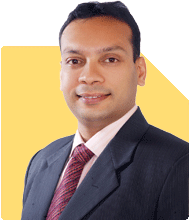Laid off from IT job after 18 years, how to manage finances with a young family?
Ramalingam Kalirajan |10878 Answers |Ask -Follow
Mutual Funds, Financial Planning Expert - Answered on Nov 20, 2024
He has an MBA in finance from the University of Madras and is a certified financial planner.
He is the director and chief financial planner at Holistic Investment, a Chennai-based firm that offers financial planning and wealth management advice.... more

I worked in IT industry for 18 years and 5 Years in MFG, lost job was getting 1.4 lakh/month , have loan of 13 lakh, rental income 20k ,PF 10 Lakh saving 5 Lakh . how to improve to income for children 12 & 3 studies and other expenses
Let’s analyse your situation from all angles and create a comprehensive financial plan.
Detailed Analysis of Your Assets and Liabilities
1. Loan Liabilities
Your outstanding loan of Rs 13 lakh is a major priority.
Paying EMIs consistently while maintaining liquidity will help ease this burden.
2. Rental Income
Rs 20,000 per month is a valuable, steady income source.
This income can support loan repayment or household expenses.
3. Provident Fund (PF)
Rs 10 lakh in PF is a significant safety net for your retirement.
Avoid using PF for immediate needs unless absolutely necessary.
4. Savings
Rs 5 lakh in savings can be utilised strategically.
Reserve a part for emergencies, and use the rest for growth-oriented investments.
Strategies to Improve Income
A. Leverage Professional Experience
Your 18 years in IT and 5 years in MFG offer opportunities to monetise your skills.
Seek freelance consulting or project-based roles in IT, supply chain, or manufacturing.
Register on platforms that connect experienced professionals to global employers.
B. Upskill for High-Demand Roles
Enrol in short-term certifications in areas like cloud computing, AI, or supply chain analytics.
Consider online platforms offering affordable courses to boost employability.
C. Explore Passive Income Streams
Convert savings into investments that generate steady returns.
Look for low-risk instruments that complement your rental income.
Loan Management
A. Prioritising Debt Repayment
Allocate rental income of Rs 20,000 monthly towards loan EMIs.
Ensure timely payments to avoid penalties and maintain your credit score.
B. Negotiating Loan Terms
Approach your lender to explore refinancing options for better interest rates.
If possible, restructure the loan to lower monthly EMIs.
C. Avoid Aggressive Prepayment
Prepay only when you have surplus funds beyond emergency reserves.
Maintaining liquidity is crucial to address unexpected expenses.
Building a Secure Financial Base
A. Emergency Fund Creation
Set aside Rs 3 lakh from your savings as an emergency fund.
Keep this fund in a liquid or ultra-safe investment to access it quickly.
B. Children’s Education Planning
Your children, aged 12 and 3, will require significant educational funds.
Start systematic investments now to meet these future needs.
C. Protecting Your Family’s Future
Ensure adequate life and health insurance coverage to protect against uncertainties.
Reassess existing policies to confirm they align with your financial goals.
Expense Management
A. Streamlining Monthly Expenses
Identify and reduce non-essential spending.
Use expense-tracking apps to monitor and control your budget.
B. Prioritising Education Costs
Focus on allocating a portion of income towards your elder child’s school fees.
Plan for higher education expenses well in advance by estimating future costs.
C. Accounting for Inflation
Factor in annual inflation, especially for education and healthcare.
Adjust your savings and investments to account for these rising costs.
Enhancing Investment Strategy
A. Systematic Investment Planning (SIP)
Start SIPs in mutual funds with a balanced mix of equity and debt exposure.
Use regular funds through a Certified Financial Planner (CFP) for expert guidance.
B. Advantages of Regular Funds Over Direct Funds
Direct funds lack the professional advice and market insights provided by CFPs.
Regular funds allow you to focus on long-term goals with less personal effort.
C. Avoid Index Funds for Better Returns
Index funds only replicate market performance without active risk management.
Actively managed funds adapt to market changes, potentially delivering higher returns.
Tax Planning for Maximum Efficiency
A. Utilising Tax Deductions
Maximise deductions under Section 80C by investing in tax-saving instruments.
Consider ELSS funds, which combine tax benefits with wealth creation.
B. Planning Withdrawals for Lower Tax Impact
Withdraw investments strategically to minimise taxable income.
Understand the latest mutual fund tax rules to optimise gains.
C. Investing for Tax Efficiency
Allocate savings in instruments offering tax-free or tax-deferred returns.
Use systematic transfer plans (STPs) to transition funds between debt and equity.
Focusing on Children’s Education
A. Long-Term Education Planning
Begin investing specifically for your children’s higher education.
Use diversified instruments to build a substantial corpus over the years.
B. Setting Milestone-Based Goals
Break down education costs into milestones (e.g., school, college, post-graduation).
Align investment timelines to meet these milestones effectively.
C. Combining Growth and Stability
Choose a balanced investment strategy to ensure growth without excessive risk.
Review your portfolio yearly to align with evolving financial goals.
Planning for Retirement
A. Preserving Your PF for Retirement
Keep PF untouched as your retirement base.
Complement it with long-term investments in growth-oriented funds.
B. Building a Secondary Corpus
Invest systematically in debt and equity funds to create an additional retirement corpus.
Maintain a diversified portfolio to reduce overall risk.
C. Ensuring Financial Independence
Target investments that generate a steady income during retirement.
Reinvest returns to grow your corpus until retirement.
Continuous Monitoring and Professional Guidance
A. Collaborate with a Certified Financial Planner
Work with a CFP to create a tailored financial plan.
Review your progress regularly and adjust as needed.
B. Monitoring Investments
Track the performance of all investments every six months.
Rebalance your portfolio to adapt to changing market conditions.
C. Staying Updated
Stay informed about new financial products and investment opportunities.
Use financial literacy to make better decisions for your family’s future.
Final Insights
You have a strong foundation with your rental income, PF, and savings. By focusing on income enhancement, debt management, and systematic investing, you can secure your family’s future. Plan strategically for your children’s education and retirement, ensuring financial stability. Stay disciplined, adaptable, and focused on long-term goals.
Best Regards,
K. Ramalingam, MBA, CFP
Chief Financial Planner
www.holisticinvestment.in
https://www.youtube.com/@HolisticInvestment
You may like to see similar questions and answers below
Krishna Kumar | Answer |Ask -Follow
Workplace Expert - Answered on Jun 04, 2024
Ramalingam Kalirajan |10878 Answers |Ask -Follow
Mutual Funds, Financial Planning Expert - Answered on Jul 25, 2024
Ramalingam Kalirajan |10878 Answers |Ask -Follow
Mutual Funds, Financial Planning Expert - Answered on Jun 01, 2025
Ramalingam Kalirajan |10878 Answers |Ask -Follow
Mutual Funds, Financial Planning Expert - Answered on Aug 02, 2025
Naveenn Kummar |235 Answers |Ask -Follow
Financial Planner, MF, Insurance Expert - Answered on Sep 04, 2025
Samraat Jadhav |2506 Answers |Ask -Follow
Stock Market Expert - Answered on Dec 11, 2025
Samraat Jadhav |2506 Answers |Ask -Follow
Stock Market Expert - Answered on Dec 11, 2025
Samraat Jadhav |2506 Answers |Ask -Follow
Stock Market Expert - Answered on Dec 11, 2025
Dr Nagarajan J S K |2577 Answers |Ask -Follow
NEET, Medical, Pharmacy Careers - Answered on Dec 10, 2025
Mayank Chandel |2570 Answers |Ask -Follow
IIT-JEE, NEET-UG, SAT, CLAT, CA, CS Exam Expert - Answered on Dec 10, 2025
Samraat Jadhav |2506 Answers |Ask -Follow
Stock Market Expert - Answered on Dec 10, 2025
Radheshyam Zanwar |6741 Answers |Ask -Follow
MHT-CET, IIT-JEE, NEET-UG Expert - Answered on Dec 10, 2025
Ramalingam Kalirajan |10878 Answers |Ask -Follow
Mutual Funds, Financial Planning Expert - Answered on Dec 10, 2025
Ramalingam Kalirajan |10878 Answers |Ask -Follow
Mutual Funds, Financial Planning Expert - Answered on Dec 10, 2025
Samraat Jadhav |2506 Answers |Ask -Follow
Stock Market Expert - Answered on Dec 10, 2025



























